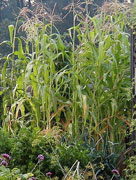


Home
Flowers &
Indoor Plants
Fruits & Nuts
Ornamentals
Vegetables
Special Topics
Resources
Glossary

Corn
|
 |
What about it? Corn has been grown for hundreds of years and is native to the Americas. For some, sweet corn is one of the greatest pleasures of summer. Sweet corn comes in a range of colors and varieties. Kernels may be yellow, white, or bicolored. "Silver Queen" and "Golden Bantam" are favorites but the supersweet types like "Early Extra Sweet" can be stored for up to 10 days without losing their sweetness. Also becoming quite popular are "blue" corn and the strawberry-colored popcorn. What is it used for? Corn can be used in a great number of ways. Native Americans are known for their creative ways of using corn. Besides eating it raw, or cooked on the cob, you can make tamales, tortillas, succotash, corn bread, popcorn, and even corn husk dolls. Where does it grow? How do we grow it? Corn plants like fertile, well drained soils with plenty of sunshine. Traditional planting of corn includes the "Three Sisters," squash and beans. Most gardeners plant corn in blocks of at least four rows. Place the seeds 1-2 inches deep and 8 inches apart. The plants will need to be thinned when they are about 5 inches tall. Corn plants need plenty of water. Supersweet corn must be isolated. What are its primary problems? If the leaves begin to yellow, you may have a nitrogen deficiency, corn is a heavy feeder. Throw some compost on that soil! What do you think you've been saving all that food waste and grass clippings for? If you don't have enough compost, you can purchase one of any number of commercial fertilizers. Bacterial wilt is a common disease, as well as corn smut, leaf rust, corn leaf blight, and maize dwarf mosaic virus. Be sure you select resistant or tolerant varieties. There are many pests that like the way that corn tastes: European corn borers, corn earworm, flea beetles, Japanese beetles, and aphids. Corn rootworms, seed corn maggots and wirewotms feed on the roots. You may also encounter birds, raccoons, and deer. If you've never made a scarecrow before, now is your chance! How do we propagate it? Plant the corn from seed about a week before the frost-free date. Plant corn in a block, not a row, to insure pollination. How do we harvest and store it? There are several different harvesting options, called harvest stages, depending on how you want your corn to taste. Baby corn can be harvested as soon as the silk appears. You can eat the whole cob. However, the milk stage is the most popular. This is when you prick the corn and a milky liquid comes out. This usually happens 3 weeks after the silks have come out. Before the milk stage is the dough stage when the kernels are slightly more tender but have less flavor. The starch stage comes after the milk stage, when the kernels press tightly against each other. This stage is "chewy." Cut corn from the stalk rather than squeezing the ear. Sweet corn varieties lose their flavor quickly. After picking, the sugar begins to convert to starch and corn quickly loses its flavor. Either eat your corn right away, or store at 32 degrees F in a plastic bag.
© Copyright, Department of Horticulture, Cornell University. |


